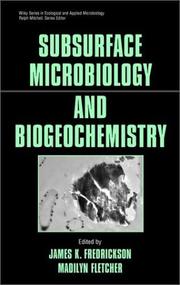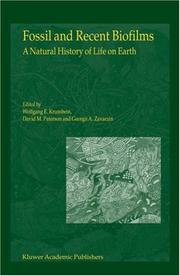| Listing 1 - 10 of 69 | << page >> |
Sort by
|
Book
ISBN: 0632006838 Year: 1983 Publisher: Oxford : Blackwell Scientific Publications,
Abstract | Keywords | Export | Availability | Bookmark
 Loading...
Loading...Choose an application
- Reference Manager
- EndNote
- RefWorks (Direct export to RefWorks)

ISBN: 0824795415 Year: 1996 Publisher: New York (N.Y.) : Dekker,
Abstract | Keywords | Export | Availability | Bookmark
 Loading...
Loading...Choose an application
- Reference Manager
- EndNote
- RefWorks (Direct export to RefWorks)
Book
ISBN: 0824711831 Year: 1981 Publisher: New York (N.Y.): M. Dekker
Abstract | Keywords | Export | Availability | Bookmark
 Loading...
Loading...Choose an application
- Reference Manager
- EndNote
- RefWorks (Direct export to RefWorks)
Book
ISBN: 9781466592407 1466592400 Year: 2016 Publisher: Boca Raton, FL : CRC Press, Taylor & Francis Group,
Abstract | Keywords | Export | Availability | Bookmark
 Loading...
Loading...Choose an application
- Reference Manager
- EndNote
- RefWorks (Direct export to RefWorks)
Book
ISBN: 9781578086658 Year: 2010 Publisher: Enfield, NH : Boca Raton : Science Publishers CRC Press,
Abstract | Keywords | Export | Availability | Bookmark
 Loading...
Loading...Choose an application
- Reference Manager
- EndNote
- RefWorks (Direct export to RefWorks)

ISBN: 047131577X Year: 2001 Publisher: New York (N.Y.) : Wiley,
Abstract | Keywords | Export | Availability | Bookmark
 Loading...
Loading...Choose an application
- Reference Manager
- EndNote
- RefWorks (Direct export to RefWorks)
Until recently, much of our understanding of microorganisms in the subsurface was largely a matter of speculation. Recent advances in technology and methodology have enabled the discovery and study of microorganisms in deep subsurface environments. Researchers are now able to explore relationships between microbial physiology, taxonomy, and genetics, and the environment of these microorganisms, including geochemical, geological, and hydrological properties. Subsurface Microbiology and Biogeochemistry is a necessary learning tool that focuses on the integration of microbiology and the geosciences.The subsurface environment provides numerous niches for microorganisms and this book presents research in subsurface microbiology in addition to providing an understanding of the broad range and diversity of the previously "hidden" subterranean organisms. Contributing chapters from experts in their respective disciplines discuss the results of deep subsurface microbiology studies and enlighten the reader as to how the subsurface environment has grown to represent a true frontier for microbiological research.Subsurface Microbiology and Biogeochemistry reviews an important topic that is at the vanguard of subsurface environment studies with implications on the search for life on other planets. The discovery of subsurface microorganisms creates a multitude of opportunities for microbiologists and engineers in academia and biotechnology, with this book at the forefront of essential reading.

ISBN: 1402015976 Year: 2003 Publisher: Dordrecht : Kluwer academic,
Abstract | Keywords | Export | Availability | Bookmark
 Loading...
Loading...Choose an application
- Reference Manager
- EndNote
- RefWorks (Direct export to RefWorks)
Book
Year: 2021 Publisher: London : IntechOpen,
Abstract | Keywords | Export | Availability | Bookmark
 Loading...
Loading...Choose an application
- Reference Manager
- EndNote
- RefWorks (Direct export to RefWorks)
Acidophiles are an important category of microorganisms defined by their ability to withstand and even grow in acidic environments. They are present in terrestrial and marine environments as well as the human body. The diversity, adaptation, and functions of these microorganisms can contribute to the development and application of new biotechnologies for resolving problems of resource exploitation, pollution, and human disease. This book presents breakthroughs and insights into the research on acidophiles. Chapters cover such topics as the two-component system (TCS) in the regulation of the sulfur metabolic process, adaptation mechanisms of acidophiles to low pH, regulation mechanisms and application strategy of quorum sensing in bioleaching bacteria, and Lactobacillus acidophilus and its potential role as a therapeutic for human bone disorders.
Book
Year: 2021 Publisher: London : IntechOpen,
Abstract | Keywords | Export | Availability | Bookmark
 Loading...
Loading...Choose an application
- Reference Manager
- EndNote
- RefWorks (Direct export to RefWorks)
Acidophiles are an important category of microorganisms defined by their ability to withstand and even grow in acidic environments. They are present in terrestrial and marine environments as well as the human body. The diversity, adaptation, and functions of these microorganisms can contribute to the development and application of new biotechnologies for resolving problems of resource exploitation, pollution, and human disease. This book presents breakthroughs and insights into the research on acidophiles. Chapters cover such topics as the two-component system (TCS) in the regulation of the sulfur metabolic process, adaptation mechanisms of acidophiles to low pH, regulation mechanisms and application strategy of quorum sensing in bioleaching bacteria, and Lactobacillus acidophilus and its potential role as a therapeutic for human bone disorders.
Book
ISBN: 1774074362 9781774074367 Year: 2020 Publisher: Oakville, ON : Delve Publishing,
Abstract | Keywords | Export | Availability | Bookmark
 Loading...
Loading...Choose an application
- Reference Manager
- EndNote
- RefWorks (Direct export to RefWorks)
| Listing 1 - 10 of 69 | << page >> |
Sort by
|

 Search
Search Feedback
Feedback About UniCat
About UniCat  Help
Help News
News